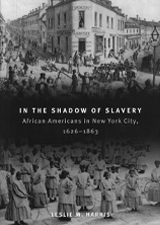Book Review
In the Shadow of Slavery: African Americans in New York City, 1626-1863
By Leslie M. Harris. Chicago: University of Chicago Press, 2003; xii + 380 pp., illustrations, maps; cloth $42.50; paper $25.00.
 |
Leslie Harris's In the Shadow of Slavery offers a powerful story of New York City's African Americans from the colonial period through the Civil War. The strength of the book lies in its capacity to synthesize a tremendous amount of scholarship on antislavery and black activism while simultaneously offering novel interpretations.
The book is built on an ambitious narrative with broad implications for understanding antebellum black activism. The trajectory of the narrative is not unfamiliar to specialists in the field. Drawing on a tradition of work stressing self-guidance and agency, Harris describes how African-descended people became African Americans in the colonial period, developing communities that established collective strategies for coping with and resisting oppression. The ideology of the Revolutionary War era loosened the fetters of enslavement, as paternalistic whites sought to enhance liberty's scope while preserving the moral well-being of the fragile republic. White reformers' efforts to expatriate American blacks to the African colony of Liberia illustrated the anxieties about emancipation. The limited benevolence of the early republic thus transmogrified into the hardened racial lines of the antebellum period.
In the 1830s, popular response to black activism and white radical abolitionism coalesced around fears of "amalgamation," spurring the riots of 1834 and fostering new caution among antislavery activists black and white. The new generation of black activists that emerged in the 1840s and 1850s was more dedicated to independent action and more willing to discuss potentially divisive questions of class culture within the movement. While their solutions failed to mobilize the full spectrum of black classes, their concerns were more than justified by the reemergence of white fears of interracial sexuality embodied in the Draft Riots of 1863.
For interpreters of historic sites, Harris's study suggests important nuances in presenting a narrative of black activism as well as the broader context of abolitionism. Far more than a case study, it is the story of the black antislavery movement writ large. Harris's key players conflict with black Philadelphians, shake off the paternalism of Boston abolitionists, establish institutions throughout the Mid-Atlantic and New England, and nurture ties to the plantation South and to Africa and other parts of the diaspora. The convention movement spearheaded by black New Yorkers in the 1840s was a national movement, and it responded to national events, like the Supreme Court's 1857 decision in Dred Scott v. Sandford.
In the Shadow of Slavery also offers highly original research and analysis. Few have done the job as well as Harris in illuminating the ambivalent, qualified "freedom" of black northerners in the early republic, or of the role of sexual fears in further qualifying that freedom in the antebellum years. Her discussion of the manual labor movement and black abolitionism constitutes some of the strongest work we have on northern blacks and questions of labor. Her study of the Colored Orphan's Asylum deftly illuminates class tensions inherent in white reformers' efforts on behalf of African Americans.
Class tensions constitute the strongest theme of the book, as Harris seeks the fullest explication yet of the role of class formation in antebellum black activism. Similar to her colleagues Shane White and Graham Hodges, Harris undertakes the formidable task of giving voice to nonelite African Americans, which inevitably yields stories of conflict with bourgeois black leaders. Figures like Samuel Cornish embraced middle-class values of self-help and moral elevation in an effort to demonstrate that African Americans deserved their precarious freedom, but often at the expense of working-class blacks whom these leaders claimed to represent. Working-class African Americans, such as Peter Paul Simons, occasionally challenged the bourgeois premises of elite black protest, only to find themselves silenced, mocked, or ignored.
Harris tends to reify class, often posing "middle class" not as the contingent product of social and ideological contestation, but as a given and thus largely the same for whites and blacks. As Harris herself notes, scanty means impelled important figures among the black elite to undertake labor that prevented them from embodying the dominant middle-class ideal. For black leaders, what did bourgeois actually mean? While Harris recognizes that black activists lacked the luxury of sundering themselves from the black non-elite, she might have more fully grasped the opportunities such paradoxes offer for interrogating divergent meanings of class among black and white activists. Was it possible for class culture to operate among blacks in the same way that it operated among whites? At the least, Harris's work suggests a tantalizing hidden history of class tension within the black community that invites further investigation.
It is no surprise that In the Shadow of Slavery won the American Historical Association's 2003 Wesley Logan Prize, and an honorable mention for the 2003 Frederick Douglass Book Prize from the Gilder Lehrman Center for the Study of Slavery, Resistance, and Abolition. Few have done as much as Harris to challenge historians to weave the African American experience into a retelling of the national narrative. The book is a stunning achievement—an insightful and wide-ranging work that may long stand as definitive.
Patrick Rael
Bowdoin College
